Welcome to Kirsten's Herbal Garden...COMFREY
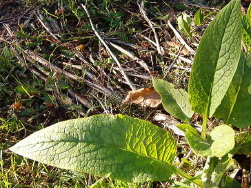
Comfrey, Vashon Island, WA 2005 (Photo: K. Anderberg)
I first became aware of comfrey when a housemate in Santa Cruz, Ca. pointed to a plant with huge leaves in the yard and said that American Indians used the leaves as pouches to carry things in. I wondered how that worked, so I picked one of the big leaves and put some rosemary leaves in it, and rolled it up. The tissues of the leaf actually held it in place, like a weak Velcro, and as it dried, it dried in the shape of the pouch, similar to a fried eggroll, but more fragile. After that experience, I have since used comfrey in lotions and oils, skin poultices and compresses, hair tonics, as pouches, and more. Comfrey (symphytum officinale) has been cultivated since approximately 400 BC, is used medicinally and cosmetically, as well as in glue, leather tanning, soap making, fabric dying, fertilizer, etc. It is native to Europe and Asia, and grows in temperate climates. It is used in England, America, Germany, the USSR, Kenya, China, Angora, Haiti, Spain, Turkey...
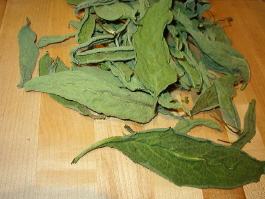 Dried Comfrey Leaves (Photo: K. Anderberg 2005)
Dried Comfrey Leaves (Photo: K. Anderberg 2005)Because of its healing properties and the Velcro-like hairs, you can use a comfrey leaf just like a bandaid. If you want to sterilize it, dip it in boiling water, then let it cool and apply to minor wound. Comfrey is known for its healing qualities. It was referred to as "Knitbone" traditionally, as it is known for knitting together tissues and promoting cell growth. It was also referred to as "Bruisewort" as it is known to reduce swelling and bruising when applied to injuries as a poultice or compress. Leaves in poultices and compresses have been applied to varicose veins and arthritic joints, as well as diaper rash. Warm, smashed or bruised leaves applied to an inflamed injury are said to help reduce swelling and bruising, as well as reduce scarring.

Comfrey has more mucilage than marshmallow, which is why it has a softening effect in skin and hair products. Comfrey tea, made from root or leaves, poured over hair as a rinse, makes hair soft as silk. You can make a nice hair tonic by making tea from stinging nettles, comfrey, rosemary and mint. Strain tea, then pour over hair as final rinse in shower. You do not need to rinse it out. Hair will feel stronger, shinier, and softer. Make fresh before each use. Susun Weed says that rubbing comfrey ointment on a vulva every morning and night will make said vulva "noticeably plumper and moister within 3 weeks." She also recommends a comfrey sitz bath for itchy vaginal tissues in menopause, using comfrey tea, for a 5-10 minute soak. She says this makes the vaginal tissues stronger, softer, and more flexible. Comfrey root compresses are also recommended for this purpose. A compress is made from comfrey root soaked in boiling water for a half hour to an hour, strained and then a towel is soaked in it. The towel is then applied to the woman's genitals as she reclines.
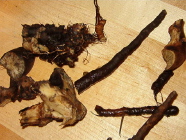
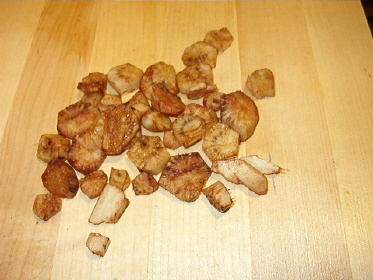
Comfrey root, before cleaning, and after, sliced, ready to dry (Photo: K. Anderberg 2005)
Comfrey has long taproots, that can go 10 or more feet into the ground to bring water and minerals from below to the surface. Both the roots and the leaves contain allantoin, which is another key ingredient involved in the healing aspects of comfrey. To dry the root, dig up root, then scrub the outsides of the root clean, like a carrot. Then cut the root up, into slices, like a carrot. Then put into a paper bag and hang in a warm place to dry. Shake the bag regularly, and the root pieces will get darker and smaller, as they dry. Store in a jar once completely dry.
 To dry comfrey leaves, you can take a needle and thread and string them like popcorn. Then hang the threaded leaves between two corners in a warm part of your home. They will dry in a short time.
To dry comfrey leaves, you can take a needle and thread and string them like popcorn. Then hang the threaded leaves between two corners in a warm part of your home. They will dry in a short time.
Comfrey is most commonly mistaken for the deadly foxglove, thus it is important that you have certain identification of plants before using them. Comfrey grows to about 4 feet high, and has large leaves with visible white hairs on them, especially on young leaves, like peach fuzz. Comfrey grows like a weed and it is hard to get rid of once it has taken hold. It has drooping flowers, in colors ranging from purple to pink to blue to white. You can pick the leaves in spring and summer, they are best before the comfrey flowers. The flowers come in late spring and summer. And the roots are usually collected in fall and winter. The leaves are high in calcium and used to be recommended as an edible green and for teas to be taken internally, but there has been much controversy in the last 20 years about possible accumulations of toxins in the liver from ingesting comfrey, and thus ingestion is not recommended in many places at this point. The studies show prolonged and excessive consumption to possibly hurt the liver, but why take chances? Thus I have not included the many uses of comfrey traditionally as a tea and internal tonic in this article.
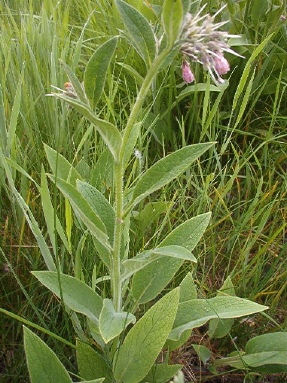
Comfrey flowering in Woodinville, WA 2005 (Photo: K. Anderberg)
Comfrey's skin-healing agents make it an invaluable cosmetic herb. You can add comfrey to your bath water to soften skin, using a muslin tea bag filled with dried or fresh leaves or root, hanging under the running spigot, and soaking it in the bath like a big teacup. You can make your own comfrey oil by putting 1 pint of oil, such as olive, almond, or coconut oils, into a glass bowl big enough to fit over a pan and not fall in. Then add 8 ounces of dried comfrey leaves. Simmer bowl over pan of boiling water for 3 hours, then strain, and bottle. It will keep about a year. You can use this oil on dried and rough skin. You can also make comfrey ointment by taking 3/4 cup of comfrey oil you made, and mixing it in the glass bowl with 1/2 ounce of grated beeswax. Melt the beeswax and oil together, stirring until they are combined. Pour into a jar while still hot and liquid. Will set and gel as it cools. This ointment is excellent for babies, apply after each cleaning, before putting on a new diaper, to help heal diaper rash. But do not use comfrey and comfrey oils and ointments on deep wounds or infected skin, as it may promote surface healing before a wound is healed underneath. Comfrey aids in speeding healing to such a point that this warning is warranted! And comfrey steeped in hot vinegar then cooled then applied to hair makes hair very soft.
Lastly, comfrey is used for fertilizer. The leaves decompose easily, thus are used to accelerate compost. Comfrey leaves are used as mulch, as well as to line potato, sweet pea and bean trenches for nutrients. A fertilizer can be made by taking a water-tight container and putting a bunch of ripped up comfrey leaves in it, then water to cover them. Seal and leave alone for 2 weeks in hot weather and 4 weeks in cold weather. Drain off the foul smelling liquid, as it is full of potash, which tomatoes, potatoes, cucumbers and peppers thrive on. Mix 1/3 of the comfrey liquid with one gallon of water as fertilizer to water plants with.
Abbreviations: (t. = teaspoon, T. = Tablespoon, c. = cup)
DISCLAIMER: Do not eat or drink tea from any plant you have not fully studied and identified properly. Please consult with your local alternative herbal care specialist before using herbs you are not familiar with.
 |
Anise * Blackberries * Calendula * Cloves * Comfrey * Eucalyptus * Fennel * Horsetails * Lavender * Mint * Nettles * Red Clover * Roses * Rosemary * Sage * Selfheal * Thyme * BABIES & MOMS * BATHS * BUG REPELLENTS * FEET * HAIR * LIPS * MAKEUP * MISC * SKIN * TEETH * WOMEN * |
Thank you to Resist.ca for hosting this website!










